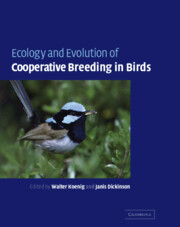Book contents
- Frontmatter
- Contents
- List of contributors
- Introduction
- 1 Evolutionary origins
- 2 Delayed dispersal
- 3 Fitness consequences of helping
- 4 Parental care, load-lightening, and costs
- 5 Mating systems and sexual conflict
- 6 Sex-ratio manipulation
- 7 Physiological ecology
- 8 Endocrinology
- 9 Incest and incest avoidance
- 10 Reproductive skew
- 11 Joint laying systems
- 12 Conservation biology
- 13 Mammals: comparisons and contrasts
- 14 Summary
- Names of bird and mammal species mentioned in the text
- References
- Taxonomic index
- Subject index
8 - Endocrinology
Published online by Cambridge University Press: 02 December 2009
- Frontmatter
- Contents
- List of contributors
- Introduction
- 1 Evolutionary origins
- 2 Delayed dispersal
- 3 Fitness consequences of helping
- 4 Parental care, load-lightening, and costs
- 5 Mating systems and sexual conflict
- 6 Sex-ratio manipulation
- 7 Physiological ecology
- 8 Endocrinology
- 9 Incest and incest avoidance
- 10 Reproductive skew
- 11 Joint laying systems
- 12 Conservation biology
- 13 Mammals: comparisons and contrasts
- 14 Summary
- Names of bird and mammal species mentioned in the text
- References
- Taxonomic index
- Subject index
Summary
In the nearly 80 years since Skutch (1935) coined the term “helper-at-the-nest,” cooperative breeding has attracted considerable interest, to no small extent because helping to raise non-descendant young violates a primary tenet of Darwinian theory. This “paradox” of how cooperative breeding could have evolved and subsequently have been maintained was partially resolved first by Hamilton (1963), who introduced the concept of kin-selected benefits by individuals that assist in rearing related individuals other than their own offspring, and later by Brown (1978), Koenig and Pitelka (1981), and Emlen (1982a), who developed the hypothesis that cooperatively breeding species were constrained by specific habitat requirements that induced philopatry, thus setting the stage for helping behavior.
Here we focus on the contributions of field endocrinology to our proximate-level understanding of cooperative breeding. Given that hormones are involved in mediating virtually all aspects of an organism's life and affect functions as diverse as gut absorption, blood production, and reproductive and agonistic behaviors, we can expect that they will also play an important role in the various kinds of cooperative and competitive interactions characteristic of cooperative breeders.
BACKGROUND
Reproductive hormones
Two endocrine axes are of primary interest here: the hypothalamo-pituitary-gonadal (HPG) axis and the hypothalamo–pituitary–adrenal (HPA) axis. The HPG axis consists of a region of the forebrain known as the hypothalamus, the pituitary that lies immediately below, and the gonads (Fig. 8.1). In response to stimulatory environmental or endogenous cues, the hypothalamus secretes gonadotropin-releasing hormone (GnRH).
- Type
- Chapter
- Information
- Ecology and Evolution of Cooperative Breeding in Birds , pp. 128 - 141Publisher: Cambridge University PressPrint publication year: 2004
- 21
- Cited by



